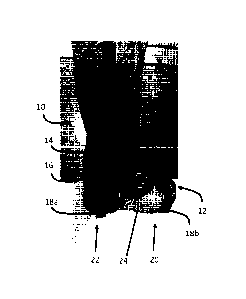Une partie des informations de ce site Web a été fournie par des sources externes. Le gouvernement du Canada n'assume aucune responsabilité concernant la précision, l'actualité ou la fiabilité des informations fournies par les sources externes. Les utilisateurs qui désirent employer cette information devraient consulter directement la source des informations. Le contenu fourni par les sources externes n'est pas assujetti aux exigences sur les langues officielles, la protection des renseignements personnels et l'accessibilité.
L'apparition de différences dans le texte et l'image des Revendications et de l'Abrégé dépend du moment auquel le document est publié. Les textes des Revendications et de l'Abrégé sont affichés :
| (12) Demande de brevet: | (11) CA 3024235 |
|---|---|
| (54) Titre français: | GUETRE POUR ARTICLE CHAUSSANT |
| (54) Titre anglais: | GAITER FOR FOOT GARMENT |
| Statut: | Réputée abandonnée |
| (51) Classification internationale des brevets (CIB): |
|
|---|---|
| (72) Inventeurs : |
|
| (73) Titulaires : |
|
| (71) Demandeurs : |
|
| (74) Agent: | ADAM MIZERAMIZERA, ADAM |
| (74) Co-agent: | |
| (45) Délivré: | |
| (22) Date de dépôt: | 2018-11-15 |
| (41) Mise à la disponibilité du public: | 2020-05-15 |
| Licence disponible: | S.O. |
| Cédé au domaine public: | S.O. |
| (25) Langue des documents déposés: | Anglais |
| Traité de coopération en matière de brevets (PCT): | Non |
|---|
| (30) Données de priorité de la demande: | S.O. |
|---|
A gaiter for a foot garment including a tubular element made of flexible
material,
the tubular element having a bottom portion, and two strips attached to the
tubular element. The two strips are positioned along the bottom portion of the
tubular element to be placed under a forefoot and under a heel respectively.
Each strip is positionable at some distance from the corresponding end of a
sole of the foot garment. The strips present two longitudinal edges which are
positioned across the sole, each longitudinal edge comprising an anti-slipping
element. The two strips are removably installable on the foot garment and
remain attached to the gaiter, while the gaiter is continuously worn by a
user.
The strips including the anti-slipping elements can therefore be easily
installed
and removed from the foot garment as the user transitions between walking on
icy and non-icy floor surfaces.
Note : Les revendications sont présentées dans la langue officielle dans laquelle elles ont été soumises.
Note : Les descriptions sont présentées dans la langue officielle dans laquelle elles ont été soumises.

2024-08-01 : Dans le cadre de la transition vers les Brevets de nouvelle génération (BNG), la base de données sur les brevets canadiens (BDBC) contient désormais un Historique d'événement plus détaillé, qui reproduit le Journal des événements de notre nouvelle solution interne.
Veuillez noter que les événements débutant par « Inactive : » se réfèrent à des événements qui ne sont plus utilisés dans notre nouvelle solution interne.
Pour une meilleure compréhension de l'état de la demande ou brevet qui figure sur cette page, la rubrique Mise en garde , et les descriptions de Brevet , Historique d'événement , Taxes périodiques et Historique des paiements devraient être consultées.
| Description | Date |
|---|---|
| Inactive : Lettre officielle | 2024-03-28 |
| Réputée abandonnée - omission de répondre à un avis relatif à une requête d'examen | 2024-02-27 |
| Lettre envoyée | 2023-11-15 |
| Lettre envoyée | 2023-11-15 |
| Réputée abandonnée - omission de répondre à un avis sur les taxes pour le maintien en état | 2023-05-15 |
| Lettre envoyée | 2022-11-15 |
| Requête visant le maintien en état reçue | 2021-11-08 |
| Requête visant le maintien en état reçue | 2020-11-12 |
| Représentant commun nommé | 2020-11-07 |
| Demande publiée (accessible au public) | 2020-05-15 |
| Inactive : Page couverture publiée | 2020-05-14 |
| Représentant commun nommé | 2019-10-30 |
| Représentant commun nommé | 2019-10-30 |
| Exigences quant à la conformité - jugées remplies | 2019-03-07 |
| Inactive : CIB attribuée | 2018-12-05 |
| Inactive : CIB en 1re position | 2018-12-05 |
| Inactive : CIB attribuée | 2018-12-05 |
| Inactive : CIB attribuée | 2018-12-05 |
| Inactive : Certificat dépôt - Aucune RE (bilingue) | 2018-11-22 |
| Exigences de dépôt - jugé conforme | 2018-11-22 |
| Exigences relatives à une correction du demandeur - jugée conforme | 2018-11-21 |
| Demande reçue - nationale ordinaire | 2018-11-19 |
| Déclaration du statut de petite entité jugée conforme | 2018-11-15 |
| Date d'abandonnement | Raison | Date de rétablissement |
|---|---|---|
| 2024-02-27 | ||
| 2023-05-15 |
Le dernier paiement a été reçu le 2021-11-08
Avis : Si le paiement en totalité n'a pas été reçu au plus tard à la date indiquée, une taxe supplémentaire peut être imposée, soit une des taxes suivantes :
Les taxes sur les brevets sont ajustées au 1er janvier de chaque année. Les montants ci-dessus sont les montants actuels s'ils sont reçus au plus tard le 31 décembre de l'année en cours.
Veuillez vous référer à la page web des
taxes sur les brevets
de l'OPIC pour voir tous les montants actuels des taxes.
| Type de taxes | Anniversaire | Échéance | Date payée |
|---|---|---|---|
| Taxe pour le dépôt - petite | 2018-11-15 | ||
| TM (demande, 2e anniv.) - petite | 02 | 2020-11-16 | 2020-11-12 |
| TM (demande, 3e anniv.) - petite | 03 | 2021-11-15 | 2021-11-08 |
Les titulaires actuels et antérieures au dossier sont affichés en ordre alphabétique.
| Titulaires actuels au dossier |
|---|
| DA NOVA SOLUTIONS INC. |
| Titulaires antérieures au dossier |
|---|
| DIANE ABRAN |